As a homeowner, you know that the perfect lawn adds both beauty and value to your home. However, it can be challenging to maintain the perfect turf with all the issues that can befall your yard. One thing that can have a significant impact on the appearance of your lawn is disease. Lawn diseases can cause a range of damages, from thin and patchy grass to dead spots. The Simple Lawns team is here to discuss the most common lawn diseases in Vancouver, Washington so that you know how to identify them and prevent them from damaging your lawn.
Brown Patch
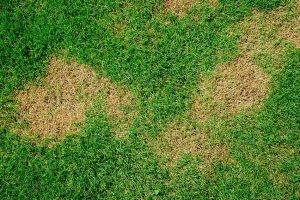
Appearance: This disease is responsible for many unsightly patches appearing all over lawns in Washington, and it is perhaps the most common of all lawn diseases. Brown patch causes roughly circular patches of yellow-to-brown grass to form over infected areas of a lawn. These patches can expand to about 3 feet in diameter, with irregular edges that resemble smoke rings around each infected patch. Infected grass within the patch will start to wilt and lose its green color, and the middle of the patch often appears sunken into the soil.
Causes: Rhizoctonia solani is the fungus that causes brown patch in cool-season grasses. This fungus attacks the leaves of plants and is often transferred/spread by lawn mowers, tools, and foot traffic. Brown patch is mainly caused by unseasonably warm weather in spring and fall, especially when it coincides with excessively damp and humid conditions.
Treatments: The best defense against brown patch is to make sure your lawn is draining and circulating air well. Aerating in early spring or fall will help prevent brown patch, as will watering early in the morning and avoiding high-nitrogen fertilizers in humid weather. Fungicides used should contain azoxystrobin, pyraclostrobin, or fluoxastrobin.
Necrotic Ring

Appearance: Necrotic ring is a common disease in Pacific Northwest lawns. It is caused by a fungus that attacks the roots of the grass. In the early stages, the disease appears as yellow rings on the lawn, and as the disease progresses, the rings turn brown. Patches of grass that are infected by this disease start around 6 inches in diameter, and they often grow much larger and merge together. Necrotic ring is well known for the “frog eye” patches of grass, which feature a center of healthy grass surrounded by a ring of dead grass.
Causes: Ophiosphaerella korrae is the fungus that causes necrotic ring. Necrotic ring thrives in areas with poor soil structure and a lack of nitrogen. Inadequate fertilization and shallow watering commonly contribute to the formation of necrotic ring.
Treatments: To control the disease, you should improve soil drainage and add nitrogen to the soil. You can also use fungicides that contain azoxystrobin, propiconazole, or thiophanate-methyl.
Red Thread
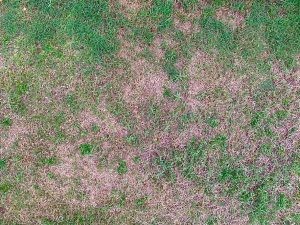
Appearance: This unique-looking disease is easily identifiable by red growths, or “threads,” spreading over infected areas of your lawn. If left untreated, these threads will begin to mat together, causing unpleasant tangles of diseased turf to form all across your yard. While Red Thread does not actually kill your grass, it does spread and thrive through dead/undernourished plant material.
Causes: Laetisaria fuciformis is the resilient red thread fungus. Cool, humid weather stimulates the spread of red thread, especially in early spring. Red thread thrives in nutrient-deficient lawns, meaning any number of issues could cause an infection of this common lawn disease. Low nitrogen is the leading cause of red thread.
Treatments: Red thread can survive in nutrient-deficient and weak lawns for years, so the best prevention plan is simply to keep your grass healthy. Seasonally appropriate fertilizers should be used throughout the year, mowing should remove only the top ⅓ of your lawn, and thatch/organic debris should be raked regularly to prevent red thread.
Dollar Spot
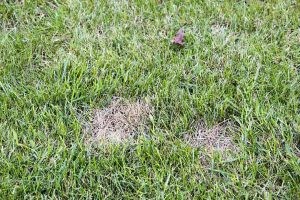
Appearance: Dollar spot is a disease that appears as small, silver-dollar sized patches on the lawn. If your lawn falls victim to Dollar spot, you will notice individual blades of grass beginning to turn tan or yellow. The affected areas will spread to form small patches (smaller than Brown Patch) of damaged grass. These damaged patches will appear to be sunken into your lawn, and they are typically about the size of a silver dollar, which is how the disease got its name.
Causes: Clarireedia jacksonii is the fungal species most often identified as dollar spot, but a few other species within the same genus are occasionally responsible. This fungus attacks the leaf blades in your lawn, as dollar spot is a foliar disease. Underfertilizing and excessive moisture commonly cause dollar spot to develop, and mowing too low makes it easy for this disease to spread.
Treatments: Avoiding excess moisture is the best way to prevent dollar spot because this disease thrives in wet, humid conditions. Underfertilizing also contributes to dollar spot issues, so make sure to properly fertilize your lawn throughout the growing season. Propiconazole and azoxystrobin are common ingredients in fungicides used to treat dollar spot.
Rust
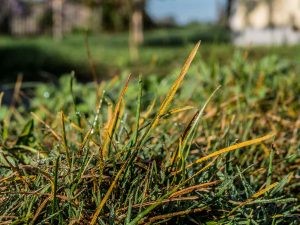
Appearance: The characteristics of this disease are exactly what one might expect from the name. The fungal disease known as rust creates flakes of yellow and orange that closely resemble rust on iron. These yellow and orange flakes are known to turn into a powdery substance that can easily rub off when touched. This disease is commonly found between summer and fall, and it develops mainly during droughts and fluctuating weather conditions.
Causes: Puccinia is the fungal genus of the rust lawn disease, but there are thousands of species that could be considered a type of “rust.” Rust develops in moderate temperatures from early spring through fall. Excessive shade, too much moisture, and underfertilizing will likely cause the rust fungi to spread.
Treatments: Rust can be effectively combated with a high-nitrogen fertilizer if symptoms are showing. Excessive moisture in shaded areas is a breeding ground for rust, so consider cutting back any trees that may be blocking sunlight from your grass, and water early in the morning so the grass has time to dry.
Snow Mold
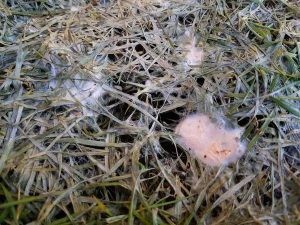
Appearance: Pink snow and gray snow mold are two similar diseases that creep into lawns over winter, and lawns start showing signs of damage as soon as snow melts in spring. Both types of snow mold cause spots of damaged grass to grow up to a foot in length, and the damaged grass typically appears matted and stiff. A pink cobweb-like growth can often be seen around the perimeter of pink mold, and gray mold spots sometimes develop hardened sclerotia in the center.
Causes: Typhula is the fungal genus of gray snow mold, and Monographella is the genus of pink snow mold. Cold, damp fall weather leading into winter is the most common cause of snow mold. This disease typically spreads underneath snow cover, but pink mold can develop even without snow. Excess shade and thatch frequently contribute to snow mold.
Treatments: The best way to prevent snow mold is to get your lawn in order before the first snowfall or frost of the season. No fungicides will work on snow mold in spring, so the best treatments are all preventive. Make sure your lawn is draining well, remove all leaves before the first snowfall, optimize direct sunlight, and make sure NOT to apply too much fertilizer/nitrogen in fall. Of course, you can always just call Simple Lawns, and let us take care of everything for you!
Subscribe to Simple Lawns's Blog




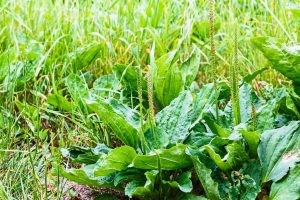

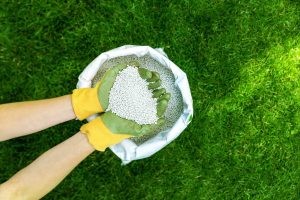

Comments